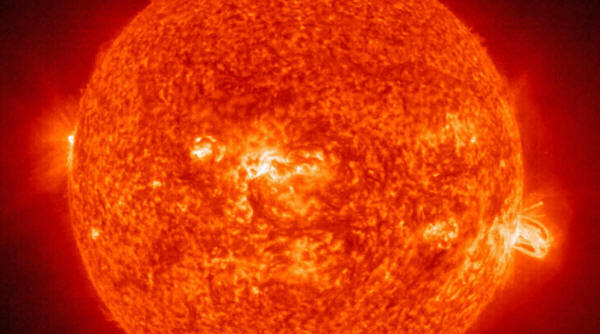|

by Brandon A. Weber
February 13,
2018
from
BigThink Website
Italian version

A new scientific study (Ultraviolet
Flux Decrease Under a Grand Minimum from IUE Short-wavelength
Observation of Solar Analogs) has just been published
that illustrates a phenomenon known as the solar "grand minimum."
Also, known as the "prolonged sunspot minimum," it's a period when
the Sun's magnetic pull will diminish, sunspots will be much less
frequent, and less ultraviolet radiation will make it to planet
Earth - all due to random fluctuations in the Sun's magnetic field.
All of that can mean
unusually cool temperatures for us, and it'll also make the Sun
appear dimmer.
The Sun is on an 11-year up/down cycle as it is, but this grand
minimum will be especially cold, as the Sun's activity will go lower
than the regular 11-year low.
That translates to
colder temperatures for large parts of the
world.

Solar Flares
Getty
Photo by NOAA
National Weather Service's Space
Weather
Prediction Center
via
Getty Images
How cold?
Predictions, based on a
study of previous sunspot reductions preceding a grand minimum
period, are that we'll see a 7% reduction in the Sun's light and
heat - and remember, that's 7% lower than the lowest of the 11 year
cycle that we usually see.
Such a grand minimum happened in the middle of the 17th
century.
Known as the "Maunder
Minimum" (from the names of 2 well respected solar
astronomers of the time, Anne Russel Maunder and Edward
Walter Maunder), the resultant cold temperatures saw the river
Thames freeze, and the Baltic Sea as well - which allowed a Swedish
army to invade Denmark by marching across the ice.
At the same time,
Alaska and Southern Greenland warmed,
due to the thinning of the Earth's stratospheric ozone layer, which
changes wind and weather patterns around the world.
The exact date and severity of the event is still in question, but
the clues all point to things bottoming out around the year 2050.
It could
start as soon as 2030, however.
Just for reference, the
Maunder Minimum lasted from 1645 until about 1715.
Will it save us from 'global
warming'?
The very same scientists
don't think so.
"The cooling effect
of a grand minimum is only a fraction of the warming effect
caused by the increasing concentration of carbon dioxide in the
atmosphere," according to the study.
I have my own prediction:
If I'm still alive by
then, I'll be heading to Jamaica...
| 


